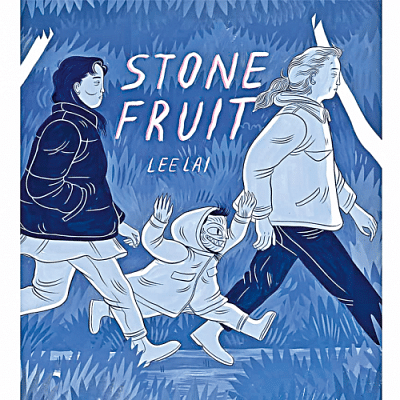Lee Lai's 'Stone Fruit': Jokes, rhymes, and the depths of relationships

One of the most searing scenes in Lee Lai's magnificent graphic novel, Stone Fruit (Fantagraphics, 2021) is when a young child, Nessie, springs into action, morphing into a feral-like creature alongside her aunt, Ray, and her girlfriend, Bron singing, jumping, and frolicking into a world of their own imagination. What begins as a rather sweet opening turns into a troubling and intensely passionate tale of what constitutes a relationship—romantic and familial—and the tension it generates between the self and one's relation to the world.
Stone Fruit delves into the minutiae of formations, transitions, transformations, and deformations of relationships. The graphic novel revolves around an inter-racial queer couple, Bron and Ray, who struggle with their relationship and with fighting the demons generated by their respective families. The most heartwarming moment they share in the entire novel is when Nessie, Ray's niece, shows up to brighten up Bron's and Ray's lukewarm existence into a vibrant symphony of jokes, gags, and rhymes. Behind the scenes, Ray struggles with her sister, Amanda, a single mother who is unable to accept her sister's relationship with Bron, and her own relationship with Nessie's father, who abandoned them. Bron on the other hand—assumed to be trans—is looking for closure with her homophobic white Christian family. With Bron's sudden withdrawal on account of their depression, Ray feels pangs of rejection and gradual distancing, which further creates a rift between the couple.
With Bron's absence, Ray feels drawn to the coldest comfort on her side, Amanda, with whom she has a strained relationship and whose communication is hinged on taking care of little Nessie while Amanda remains at work. A cycle of examination of each character's ties with their own desires and expectations, alongside the deeply paradoxical nature of what it means to love and be loved, pulls one closer to the characters and their well-spring of emotional turmoil. In order to balance the rifts of the heart, the characters are forced not to confront each other, but with their inner voices lurking within.
Lee Lai's artwork is finely drawn in a monochromatic fashion, with shades of blue and white. The artwork progresses gracefully, with alternately emotive and climactic scenes of intimate soliloquies. Stone Fruit is a painful, heartwarming, and deeply meditative read which makes a demand of you as a reader to reflect on the relationships that sustain us. Taking a close, hardened look at the relationships of the female characters without wooly-eyed idealism, it compels us to look into our own lives with an empathetic, self-reflective glance.
Israr Hasan is a Senior Research Assistant at BRAC James P Grant School of Public Health.

 For all latest news, follow The Daily Star's Google News channel.
For all latest news, follow The Daily Star's Google News channel. 



Comments